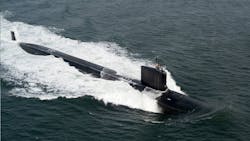General Dynamics moves ahead on Virginia-class Block VI attack submarines and sensors for undersea warfare
Summary points:
- The Virginia-class Block VI submarines will be the U.S. Navy's most advanced attack submarines to date.
- Virginia Block VI submarines will feature stealth, propulsion, and seabed warfare technologies, and the Virginia Payload Module for Tomahawk missile capacity.
- The first three Virginia-class Block VI submarines -- USS Potomac, USS Norfolk, and USS Brooklyn -- are expected to enter service starting in 2034.
WASHINGTON – Submarine experts at General Dynamics Corp. are preparing to build the most advanced version of the Virginia-class fast attack submarine (SSN 774) -- an undersea warfare weapon expected to bring its reconnaissance and lethality from the ocean's surface to the seabed.
Officials of the Naval Sea Systems Command in Washington announced a $1.9 billion order in late June to the General Dynamics Electric Boat segment in Groton, Conn., for long-lead items for the Virginia Class Block VI submarines.
The Virginia Block VI submarines are to feature technology improvements in stealth, propulsion, and weapons, and should be among the best submarines in the world for interacting with the water column from the surface to the seabed.
Long-lead items either are difficult and time-consuming to obtain, and are funded early in the aircraft design process to keep overall production on schedule.
Virginia Payload Module
The Virginia Block VI boats will be the second block of Virginia-class attack submarines with the Virginia Payload Module for large-scale land strike missiles.
The Virginia Payload Module places four multiple all-up-round canisters in the middle of the submarine in addition to two in the bow. Each tube can contain seven Tomahawk land-attack missiles.
Not only does the Virginia Block VI add land-attack firepower to the fleet, but it also offers the opportunity for the Navy to design mission-specific submarines.
First three Block VI boats
The first three planned Virginia-class Block VI submarines are the USS Potomac SSN 814); USS Norfolk (SSN 815); and USS Brooklyn (SSN 816). A contract to build the Potomac is expected later this year, and the boat should be delivered and commissioned in 2034 or 2035.
Major electronics subcontractors to General Dynamics on the Virginia-class Block VI submarine are expected to be General Atomics Electromagnetic Systems (GA-EMS) for Virginia Payload Tubes (VPT); BAE Systems Electronic Systems for electronic warfare (EW) and combat systems; Northrop Grumman Corp. for sonar arrays and other sensors; and L3Harris for communications and imaging systems.
The Navy is expected to order at least one Virginia Block VI specially designed for seabed warfare for undersea espionage and other special missions. Seabed warfare is defined as operations to, from, and across the ocean floor.
Seabed warfare
The overall target of seabed warfare is infrastructure in place on the seabed such as power cables, telecommunications cables, or undersea mining systems.
On this order, General Dynamics will do the work in Sunnyvale, South El Monte, and El Cajon, Calif.; Tucson, Ariz.; Chesapeake and Ashland, Va.; Dallas; York and McKeesport, Pa.; Westminster and Warren, Mass.; Manchester, N.H.; Huntington, W.Va.; Minneapolis; Spring Grove, Ill.; Louisville, Ky.; Camden, N.J.; and Yaphank, N.Y., and should be finished by September 2035.
For more information contact General Dynamics Electric Boat online at www.gdeb.com, or Naval Sea Systems Command at www.navsea.navy.mil.
About the Author
John Keller
Editor-in-Chief
John Keller is the Editor-in-Chief, Military & Aerospace Electronics Magazine--provides extensive coverage and analysis of enabling electronics and optoelectronic technologies in military, space and commercial aviation applications. John has been a member of the Military & Aerospace Electronics staff since 1989 and chief editor since 1995.
